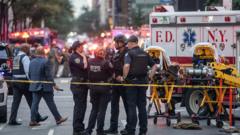In the heart of Midtown Manhattan, 345 Park Avenue, an iconic 44-story skyscraper, became a scene of terror Monday evening when a shooting erupted, shocking employees and commuters alike. As the sun set on a stifling July evening, workers scrambled for safety, barricading themselves in conference rooms and sending urgent messages to loved ones. "I texted my parents, 'I love them'," recounted Jessica Chen, who was on the second floor during the incident. The chaos began around 6:30 PM EST when a 27-year-old man, Shane Tamura, arrived at the building after a long cross-country journey from Las Vegas. Armed with an assault-style rifle, he unexpectedly opened fire in the lobby, resulting in tragic fatalities, including a New York police officer and several civilians.
Tamura had parked his black BMW, donned a jacket, and brandished his weapon as he approached the towering skyscraper, seemingly targeting the National Football League (NFL) offices located there. His first shot struck Officer Didarul Islam, who was patrolling the entrance, leaving behind a devastated family, while the rampage continued inside, taking more lives and leaving others injured. Amid the pandemonium, employees could hear the gunshots echoing from the lobby. Another security guard attempted to trigger an alarm but was also fatally shot.
In a twist of fate, Tamura mistakenly boarded the wrong elevator while fleeing the scene, leading him to the offices of Rudin Management on the 33rd floor instead of his intended target. Employees across the building reacted quickly, utilizing digital communication tools to warn others of the shooter. Witnesses outside reported hearing the gunfire and seeing terrified individuals fleeing the building with their hands raised.
The situation escalated as Tamura continued shooting on the 33rd floor, ultimately taking his own life after a short rampage that left the building in disarray. Investigators found a disturbing three-page note on him, suggesting he suffered from a brain disease potentially linked to his history with football. With Tamura's mental health issues documented, officials are now piecing together the events leading to the deadly shooting, marking another tragic chapter in the ongoing conversation about gun violence in the U.S.
As the city grapples with the aftermath, community members remember the victims while searching for answers and solutions to prevent further tragedies.
Tamura had parked his black BMW, donned a jacket, and brandished his weapon as he approached the towering skyscraper, seemingly targeting the National Football League (NFL) offices located there. His first shot struck Officer Didarul Islam, who was patrolling the entrance, leaving behind a devastated family, while the rampage continued inside, taking more lives and leaving others injured. Amid the pandemonium, employees could hear the gunshots echoing from the lobby. Another security guard attempted to trigger an alarm but was also fatally shot.
In a twist of fate, Tamura mistakenly boarded the wrong elevator while fleeing the scene, leading him to the offices of Rudin Management on the 33rd floor instead of his intended target. Employees across the building reacted quickly, utilizing digital communication tools to warn others of the shooter. Witnesses outside reported hearing the gunfire and seeing terrified individuals fleeing the building with their hands raised.
The situation escalated as Tamura continued shooting on the 33rd floor, ultimately taking his own life after a short rampage that left the building in disarray. Investigators found a disturbing three-page note on him, suggesting he suffered from a brain disease potentially linked to his history with football. With Tamura's mental health issues documented, officials are now piecing together the events leading to the deadly shooting, marking another tragic chapter in the ongoing conversation about gun violence in the U.S.
As the city grapples with the aftermath, community members remember the victims while searching for answers and solutions to prevent further tragedies.





















